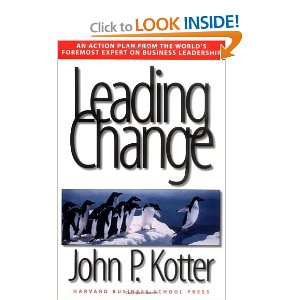This book, while it was written some time ago, still is relevant and has value in corporate world as well as with not for profit organizations as well. I recommend reading this book if you are interested in organization change models and theories. DRL
Editorial Reviews
From Publishers Weekly
Harvard Business School professor Kotter (A Force for Change) breaks from the mold of M.B.A. jargon-filled texts to produce a truly accessible, clear and visionary guide to the business world's buzzword for the late '90s?change.
In this excellent business manual, Kotter emphasizes a comprehensive eight-step framework that can be followed by executives at all levels.
Kotter advises those who would implement change to foster a sense of urgency within the organization. "A higher rate of urgency does not imply everpresent panic, anxiety, or fear. It means a state in which complacency is virtually absent." Twenty-first century business change must overcome overmanaged and underled cultures. "Because management deals mostly with the status quo and leadership deals mostly with change, in the next century we are going to have to try to become much more skilled at creating leaders."
Kotter also identifies pitfalls to be avoided, like "big egos and snakes" or personalities that can undermine a successful change effort. Kotter convincingly argues for the promotion and recognition of teams rather than individuals. He aptly concludes with an emphasis on lifelong learning. "In an ever changing world, you never learn it all, even if you keep growing into your '90s." Leading Change is a useful tool for everyone from business students preparing to enter the work force to middle and senior executives faced with the widespread transformation in the corporate world. 60,000 first printing; $100,000 ad/promo; dual main selection of the Newbridge Book Club Executive Program; 20-city radio satellite tour. Copyright 1996 Reed Business Information, Inc.
From Library Journal
After trying an endless array of quick fixes and other panaceas, executives struggling to stay in business in a rapidly changing world are finding it necessary to consider more fundamental reasons for their lack of success. Kotter (The New Rules: A Force for Change, Free Pr., 1995) now offers a practical approach to an organized means of leading, not managing, change. He presents an eight-stage process of change with highly useful examples that show how to go about implementing it. Based on experience with numerous companies, his sound advice gets directly at reasons that organizations fail to change, reasons that concern primarily the leader.
This is a solid, substantive work that goes beyond the cliches and the consultant-of-the-month's express down yet another dead-end street. With its clear demonstration of the hard work necessary to lead change, this important work stands with Michael Hammer's latest, Beyond Reengineering (see review above). Highly recommended.?Dale F. Farris, Groves, Tex.
Copyright 1996 Reed Business Information, Inc.
